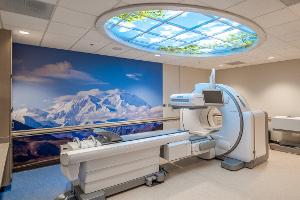Home > Imaging & Radiology > Imaging Services > Nuclear Medicine
Nuclear Medicine
Nuclear Medicine
Nuclear medicine uses a small amount of radioactive material or tracer, a special gamma camera (like a big Geiger counter) and a computer to form images. The tracer is commonly injected, but may also be swallowed or inhaled. You will need to wait a few minutes, hours or even a few days before having your scan. This allows for the tracer to concentrate in the part of your body being studied. One of the unique features of a nuclear medicine scan is that, based on the degree to which the tracer is absorbed or “taken up” by a particular organ, the examination shows the “function” as well as the size, shape and position of the organ or tissue being evaluated as opposed to just a picture. This helps to determine if the organ is working properly. Commonly performed nuclear medicine exams involve imaging of the following:
-
Heart – to identify blood flow to the heart or a specific vessel. We also scan to evaluate the extent of damage to the heart muscle after a heart attack.
-
Bones – to evaluate degenerative or arthritic changes in joints, bone disease or the cause of bone pain or inflammation
-
Gallbladder – identify inflammation or abnormal function
-
Thyroid – measures function of the gland. Nuclear Medicine also offers treatment options for certain thyroid conditions.
-
Lung – used to locate a blood clot or embolism in the lung
-
Stomach – how it empties
How to prepare for your nuclear medicine scan:
It’s very important that you follow any preparation instructions we provide for your examination. These may include specific information about eating and whether or not you should take your routine medications. Wear loose comfortable clothing for your test. Be sure to let your technologist know about all medications and herbs you’re currently taking. Also, be sure to mention any recent CT imaging studies involving an iodine injection or oral contrast media taken such as for an Upper GI or Barium Enema study. If there’s any chance you might be pregnant or are breast feeding let your technologist know prior to your radiotracer injection.
What to expect during your nuclear medicine examination:
Your examination will be performed by a registered nuclear medicine technologist. It’s possible that you will come in first for the administration of the tracer and then return later for the actual scan. Sometimes the entire procedure may be done during one visit. There are also exams that require multiple visits in a day or over a few days. The actual imaging time varies anywhere from less than an hour to several hours. When the exam starts you’ll lie on a special exam table and be made as comfortable as possible. You’ll be able to listen to what ever type of music you like during most nuclear medicine procedures. It’s important for you to be able to lie still for the study. The technologist will be with you during the exam to assist in making you comfortable. The gamma camera may be close to the area of your body that’s being examined while the images are formed. Before you leave our department the technologist will review your images to ensure that we’ve obtained all the information our radiologist needs to interpret your study.
After your nuclear medicine examination:
You may resume your normal activities after your scan. If any special instructions are necessary you’ll be informed by your technologist. Through the natural process of radioactive decay the small amount of radiotracer in your body will lose radioactivity over time. It will also pass out of you through your urine or stool within 48 to 72 hours. You should also drink plenty of water to help flush the radioactive material out of your body as instructed by your technologist. Your technologist will send your images to a Board Certified Radiologist with special training interpreting nuclear medicine examinations. S/he will analyze the images and send the results to your healthcare provider. Your provider will discuss the results with you. New technology allows us to distribute reports and images over the Internet to many providers and facilities.
